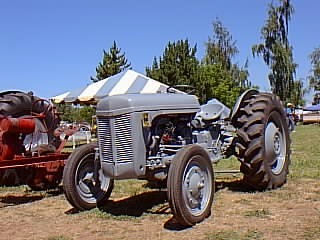Ferguson TO20 Parts
When the infamous "Handshake Agreement" between Henry Ford and Harry Ferguson fell by the wayside (that's a story in itself), Harry Ferguson quickly set up manufacturing plants for a United States version of his English TE-20. The TO-20 was relatively the same as the TE-20 except utilized some different casting materials and had a US-style electrical system. The TO-20 was a dead ringer for the Ford 9N and 2N models and they say that Ferguson did this on purpose when the Handshake Agreement went bad in an attempt to take away Ford's market for the N-Series tractors. The main difference between the TO-20 and the Ford 9N/2N was a four-speed transmission and an overhead-valve engine. A few minor improvements were also made, including a pedal for the left brake on the right side and a one-piece hood arrangement. The first TO-20 rolled off the production line in 1948 with Serial Number 1. It was an immediate success - they were reliable and priced competitively with Ford's new 8N. Due to their extreme reliability, many of the TE-20s were used in Antarctica by the British exploration program. Three of them (especially equipped) carried the famous Sir Edmund Hillary expedition on a 1,200 mile trip to the South Pole. The TO-20 was made until 1951, when the TO-30 was introduced.
The Ferguson TO-20 Today Today many of these tractors are still in use. Parts are readily available for both the TO-20 and the TE-20 with exception of the TE's Lucas electrical system (many of the English made TE-20's in the U.S. have had the Lucas system replaced by the Delco). This tractor is also popular for restoration and show - we have seen several at tractor shows around the country. In the absence of the collector standing by to defend his tractor, they are often mistaken as a 9N or 2N. An interesting side note: Although these tractors are nearly identical in looks to the 9N and 2N, very few parts are interchangeable.
The Specs
Air Cleaner: Donaldson or Vortox, circulating oil bath and multiple screen
Nebraska Tractor Test Results TEST NO. 392 Model: Ferguson TE-20 (no test available for the TO-20) Harry Ferguson Ltd., Coventry, England DATE TESTED: April 26 to May 10 1948 During 67-1/2 hours of engine operating time for this test, no repairs or adjustments were recorded except for replacing the fan belt, along with removing and cleaning the cylinder head at one point during the test. The TE-20 featured a Continental four-cylinder I-head engine rated at 1,750 and 2,000 rpm. It carried a 3-3/16 x 3-3/4 inch bore and stroke. Accessories included a Lucas coil and starter, Delco-Remy distributor, and Marvel-Schebler TSX-312 carburetor. Standard equipment also included 10-28 rear and 4.00-19 inch front tires. Advertised speeds of 2.9, 3.99, 5.5 and 11.49 mph were used, with second gear being selected for Test H. This test revealed a rated drawbar load of 16.35 horsepower, along with a pull of 1,666 pounds at 3.68 mph and slippage of 4.42%. Fuel economy at rated drawbar load was 8.99 horsepower hours per gallon of gasoline. Test C for operating maximum load yielded an economy of 10.57 horsepower hours per gallons of gasoline at a load of 24.02 belt horsepower. At a rated brake load of 22.59 horsepower, fuel economy was recorded at 10.34 horsepower hours per gallon. Also of note, the TE-20 made a maximum low-gear pull of 2,650 pounds in Test G, but with 754 pounds of added weight for each rear wheel. Bare tractor weight was 2,760 pounds.
Serial Numbers
|
|||||||||||||
We sell tractor parts! We have the parts you need to repair your tractor - the right parts. Our low prices and years of research make us your best choice when you need parts. Shop Online Today.
Copyright © 1997-2024 Yesterday's Tractor Co.
All Rights Reserved. Reproduction of any part of this website, including design and content, without written permission is strictly prohibited. Trade Marks and Trade Names contained and used in this Website are those of others, and are used in this Website in a descriptive sense to refer to the products of others. Use of this Web site constitutes acceptance of our User Agreement and Privacy Policy TRADEMARK DISCLAIMER: Tradenames and Trademarks referred to within Yesterday's Tractor Co. products and within the Yesterday's Tractor Co. websites are the property of their respective trademark holders. None of these trademark holders are affiliated with Yesterday's Tractor Co., our products, or our website nor are we sponsored by them. John Deere and its logos are the registered trademarks of the John Deere Corporation. Agco, Agco Allis, White, Massey Ferguson and their logos are the registered trademarks of AGCO Corporation. Case, Case-IH, Farmall, International Harvester, New Holland and their logos are registered trademarks of CNH Global N.V.
Yesterday's Tractors - Antique Tractor Headquarters
Website Accessibility Policy


